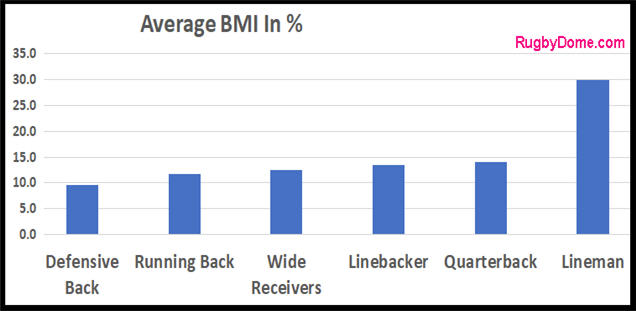The average weight of wide receivers in the NFL is 200 lbs in recent years. This is one of the lightest positions in football.
Wide receivers in college football have an average weight of 190 lbs.
Why Are Wide Receivers Lighter Than Other Positions?
Wide receivers average about 114 lbs lighter than offensive linemen. That difference is the size of an eighteen-year-old young woman!
They are also lighter than running backs, quarterbacks, and linebackers. Here is how they stack up:

The reason is due to their role on the field.
The primary role of the wide receiver is to catch passes from the quarterback. He stands out wide in the field and leaps to catch the ball overhead.
Wide receivers also have to be fast in order to outrun defenders and agile enough to swerve around them.
Fast and agile players tend to be lighter. This is why the position is lighter.
Weights across the positions
| NFL | lbs |
| Offensive Line | 314 |
| Linebacker | 245 |
| Quarterback | 225 |
| Running Back | 214 |
| Wide Receiver | 200 |
| Defensive Back | 200 |
If you want more details about the other positions, check out these in-depth articles:
- Average lineman weights in NFL and college football
- Average linebacker weights in NFL and college football
- Average quarterback weights in NFL and college football
- Average running back weights in NFL and college football
- Average defensive back weights in NFL and college football
How Do NFL Wide Receivers Compare To College Football?
College football players aren’t as heavy as professional NFL players, but they can still be pretty big.
The average weight of wide receivers in college football is 190 lbs, which is about ten pounds lighter when compared to the NFL.
That means college receivers don’t have to pile on as much weight as other positions in their rookie season in the NFL.
For example, Greg Ruegamer was a talented lineman at Arizona State who weighed 290 lbs in his senior year. The Miami Dolphins coach got on the phone to him on NFL draft day and asked him to add another 30 lbs to his bulk.
Receivers aren’t under the same kind of pressure when transitioning from college football.
How Do Receivers Compare To The Average American Male?
The average American man weighs 196 lbs according to the CDC. That’s just four pounds less than the average NFL wide receiver.
But what about body fat percentage?
A study in 2013 found that wide receivers have an average body fat percentage of 12.5%.
The average male in the United States has a percentage of about 28%, which makes wide receivers significantly leaner.
That may not surprise you. But how does this compare to the heaviest position in the NFL? Linemen clock in at nearly 30%.
Here’s a comparison across the positions:

History Of Average Weights Of Wide Receivers In The NFL
It’s difficult to compare weights through history as positions and roles have changed significantly.
Wide receivers have become faster through the decades.
If we look at the 1960s, you’ve got Boyd Dowler of the Green Bay Packers weighing in at 220 lbs.
Then there’s Harlon Hill with the Bears (and fewer seasons with the Steelers and the Lions). Hill was about 190 lbs.
Max McGee of the Green Bay Packers was in the middle of this illustrious trio at 205 lbs.
It’s a small sample, but older NFL fans will surely agree that wide receivers are a little taller and lighter now than they used to be.
How Do Wide Receivers Compare To Other Sports?
Let’s take a look at heavyweights in boxing. Anthony Joshua weighs about 240 lbs, which is significantly heavier than the average wide receiver.
But receivers are 30 lbs heavier than the average weight of soccer players recorded at the 2018 World Cup.
But it doesn’t make a whole lot of sense to compare NFL with soccer players. We should look at another contact sport.
Rugby is probably the closest sport.
Wide receivers versus rugby wingers
Of course, the positions and roles don’t line up easily when comparing the two games. But we figure that wingers in rugby are the closest position to wide receivers in football.
Why? Because wingers hang out in the widest positions (on the wing of course!) and are usually the fastest players on the pitch.

As you can see from the graphic, wingers average out at four pounds heavier than wide receivers in the NFL.
If you’d like more details, we’ve got an article comparing the size of NFL players to rugby players across multiple positions.